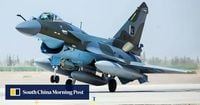In a year already marked by escalating tensions and global uncertainty, a new report from the bipartisan US-China Economic and Security Review Commission has cast fresh light on the complex dynamics behind the May 2025 India-Pakistan border conflict. The commission’s findings, released on November 19, 2025, detail how China seized the moment to both trial its latest military hardware and wage an aggressive campaign of influence across international defense markets—moves that have sent ripples through South Asia and beyond.
According to the commission, Beijing “opportunistically leveraged the conflict to test and advertise the sophistication of its weapons.” The report highlights that the May skirmish marked “the first time China’s modern weapons systems … were used in active combat, serving as a real-world field experiment.” Among the systems making their combat debut were the HQ-9 air defense network, the PL-15 beyond-visual-range air-to-air missile, and the much-touted J-10C fighter jets. Pakistan, a long-standing recipient of Chinese military technology, claimed to have shot down at least five Indian aircraft—including French-made Rafales—using the J-10C jets during the four-day clash.
While the commission stopped short of labeling the episode a full-fledged “proxy war,” it emphasized that Pakistan’s military success, aided by Chinese weaponry, was significant for both countries. For China, the conflict served as a “real-world field experiment” to validate its arms in combat—an invaluable marketing opportunity as it seeks to expand its defense industry’s global footprint. For Pakistan, the edge provided by China’s advanced systems was a boon amid its “ongoing border tensions with India and its expanding defence industry goals.”
But the military maneuvers only tell part of the story. The report goes on to allege that, in the wake of the conflict, China “initiated a disinformation campaign to hinder sales of French Rafale aircraft in favor of its own J-35 jets, using fake social media accounts to propagate AI images of supposed debris from the planes that China’s weaponry destroyed.” These efforts, according to the commission, were aimed at undermining the reputation of the Rafale—a direct competitor to China’s growing stable of fighter jets—while boosting the appeal of Chinese alternatives in the lucrative international arms market.
The campaign’s reach wasn’t limited to social media manipulation. Chinese Embassy officials reportedly “convinced Indonesia to halt a purchase of Rafale jets already in process, furthering China’s inroads into other regional actors’ military procurements.” This move, if confirmed, would represent a significant win for Chinese defense diplomacy and a setback for French ambitions in Southeast Asia.
The backdrop to these developments is a steadily deepening China-Pakistan military relationship. The US-China Economic and Security Review Commission notes that “in November and December 2024, China and Pakistan held the three-week Warrior-VIII counterterrorism drills, and in February 2025, China’s Navy participated in Pakistan’s multinational AMAN drills, highlighting China’s and Pakistan’s growing defence cooperation.” This pattern of joint exercises and defense engagement has only intensified, culminating in China’s June 2025 offer to sell Pakistan 40 J-35 fifth-generation fighter jets, KJ-500 early warning aircraft, and ballistic missile defense systems.
In a further sign of Islamabad’s shifting priorities, June 2025 also saw Pakistan announce a 20 percent increase in its 2025-2026 defense budget, raising planned expenditures to a hefty USD 9 billion—even as the country’s overall budget shrank. The commission’s report suggests this uptick is directly linked to Pakistan’s desire to modernize its military and deepen its partnership with Beijing, a relationship that has become a cornerstone of its strategic calculus in the face of persistent tensions with India.
Of course, the May conflict was itself the latest flashpoint in a long and bitter rivalry between India and Pakistan. The immediate trigger was a deadly terror attack in Pahalgam, Jammu and Kashmir, in April 2025, which left 26 people dead. In response, India launched precision strikes on Pakistani terror camps under Operation Sindoor, setting off a chain of events that led to the border clashes in May. The violence, though short-lived, was fierce—and the deployment of advanced Chinese weaponry marked a new chapter in the region’s military balance.
Meanwhile, the geopolitical reverberations of the conflict have reached all the way to Washington. On the same day the commission’s report was published, US President Donald Trump reiterated his claim that he had personally intervened to halt hostilities between India and Pakistan. During a bilateral meeting with Saudi Arabia’s Crown Prince Mohammed bin Salman, Trump told reporters, “We’ve done a lot of good with this office. I’ve stopped eight wars. I’ve actually stopped eight wars. I have another one to go with Putin. I’m a little surprised at Putin. It’s taken longer than I thought. But we stopped India and Pakistan. I could go through the list. I’m very proud. I stopped one that was almost ready to start again. So it all took place right here in the Oval Office, whether by telephone or whether they came in. Many of these leaders have come in and signed their peace deals in the Oval Office.”
Trump has consistently credited his use of trade tariffs and direct diplomacy for “settling” the India-Pakistan conflict within 24 hours—a claim that has been firmly denied by Indian officials. “I got it done (ceasefire). There are others. If you look at India and Pakistan, I could say almost any one of the deals that I’ve already done I thought would have been more difficult than Russia and Ukraine, but it didn’t work out that way,” he told journalists aboard Air Force One in October. While the veracity of these claims is disputed, they highlight the enduring importance of the US as a power broker in South Asian affairs—and the political capital at stake for leaders eager to claim credit for peace.
As for China, its embassy in Washington has so far declined to comment on the commission’s findings. But analysts say the report’s revelations—spanning battlefield technology, information warfare, and high-stakes arms diplomacy—underscore the multifaceted nature of Beijing’s strategy in the region. By simultaneously supporting Pakistan militarily, undermining its rivals through disinformation, and aggressively courting new defense clients, China is positioning itself as a central player in the evolving security architecture of Asia.
For India, Pakistan, and their partners, the events of 2025 serve as a stark reminder that the region’s fault lines are as much about perception and influence as they are about tanks and missiles. The question now is how these overlapping contests—military, diplomatic, and informational—will shape the next chapter in South Asia’s uneasy peace.




